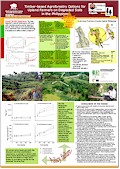| Poster |
 |
|
| Title | Timber-based Agroforestry Options for Upland Farmers on Degraded Soils in the Philippines | | Author | Fernando Santos Martin | | Year | 2008 | | Publisher | World Agroforestry Centre - ICRAF, SEA Regional Office | | City | Bogor, Indonesia | | Call Number | PO0164-08 |
|
| Abstract: |
| If open-access forest still remains in the area, farmers don’t plant timber trees. Land tenure, the level of land fragmentation and the total area managed have strong effects on farmers’ attitude to plant timber trees. Cultural, demographic, labor availability and economic considerations didn't show a significant effect in the model. The three indigenous tree species differ in their growth performance and respond to “site” properties. Four site descriptors (land position, soil type, soil texture and soil chemistry) could account for 14-74% of variation in tree performance depending on the tree species. Substantial variation in tree performance could not be explained by the biophysical indicators, implicating that farmers take considerable risk in planting trees on the basis of current ‘scientific’ knowledge. The WanFBA model can be used as non-destructive tool to predicting above-ground tree biomass and its components (Wood and Leaves). The “b” factor of the tree biomass allometric equation has a substantial variation among tree species around the claims of a universal value of 8/3. According to WaNuLCAS scenarios there is considerable scope for intercropping with “slow” growing timber trees, with systems that yield about half of the maximum tree biomass still allowing 70% of monoculture maize yield. Higher tree densities will lead to a loss of maize yield that is proportional to the gain in wood volume opportunities. Trees directly benefit in an intercrop system from the input (i.e. fertilizer) that are applied to the crops. Pterocarpus indicus and Vitex parviflora stood out as promising “agroforestry" timber tree at intermediate densities. In a non-fertilization scenario intercropping or monocropping systems with Maize are not sustainable. Timber-based systems offer better returns to land and labor than monocropping activities, up to discount rates of at least 15%. Intercrop systems are well buffered from economic risk. Thus, a gradual transition from an annual food crop system to timber-based production systems adapted to the soil conditions can be attractive for farmers |
|
|
Download file(s): Click icon to download/open file.
|
| |
File Size |
Description |

|
795 KB |
Softcopy |
|
|
GRP 5: Improving the ability of farmers, ecosystems & governments to cope with climate change
GRP 6: Developing policies and incentives for multifunctional landscapes with trees that provide environmental services
|
| Viewed in 1883 times. Downloaded in 482 times. |